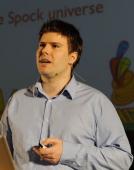2GX Session Descriptions
Burt Beckwith - Core Member of the Grails Development Team
Securing Grails Applications
When you think about securing a Grails application, you probably think of the Spring Security and Shiro plugins. But these plugins only control access to your pages and objects – what about guarding agains cross-site scripting (XSS), cross-site request forgery (CSRF) and SQL injection attacks? The OWASP project maintains a list of the top 10 web application security risks.
Grails Transactions
Properly performing multiple data updates requires a transaction, but how do we do this in Grails? Services are the best option, but there are different approaches that can be used.
Grails Plugin Best Practices
Grails plugins are a great way to reuse and share common code, and to modularize an application. In this talk we'll look at the general process for creating a plugin.
Jeff Scott Brown - Core Member of the Grails Development Team
An Introduction To Web Development With Grails 2
Grails brings the powerful "coding by convention" paradigm to Groovy and Java. Grails is not just another flavor in the pool of web development frameworks for Java. Grails leverages the powerful dynamic features of Groovy while taking advantage of best of breed technologies like Hibernate, Spring and Sitemesh to make web application development both fun and easy.
Advanced Web Development Techniques With Grails 2
Getting started building web applications for the Java platform is easy. Following that through to rich interactive applications that solve the business needs is more tricky. Grails 2 goes the whole way to address pain points not only for simple applications but of real enterprise applications with real demands. This session steps through many of the advanced features of Grails 2 that help get your applications through that last 20% that teams often struggle with. This session is not the standard hello world CRUD introduction to Grails.
Metaprogramming With The Groovy Runtime - Part 1 of 2
The dynamic runtime nature of Groovy is one of the things that sets it apart from standard Java and makes it a fantastic language for building dynamic applications for the Java Platform. The metaprogramming capabilities offered by the language provide everything that an application development team needs to build systems that are far more capable than their all Java counterparts. This Part 1 of 2 will cover the runtime metaprogramming capabilities of Groovy. The session will dive deep into Groovy's Meta Object Protocol (MOP) which implements the incredibly dynamic runtime dispatch mechanism. The session will include a lot of live code demonstrating really powerful runtime features of the language.
Metaprogramming With The Groovy Compiler - Part 2 of 2
The dynamic runtime nature of Groovy is really powerful and really flexible. The runtime capabilities of the language allow for a lot of capabilities that are not possible with less dynamic languages. Those runtime capabilities are really powerful but are not the whole story of Groovy's dynamic capabilities. Groovy also allows for a lot of dynamic behavior to be introduced at compile time. Participating in the compilation process isn't something that application developers are generally used to doing, but Groovy makes it somewhat easy to jump into that process without having to write a whole compiler of your own. This session will dive deep into the features of Groovy that allow for you to participate in the compilation process to control what the compiler emits. You will learn to add methods to classes, modify existing and more, all at compile time.
Polyglot Web Development With Grails 2
Grails is one of the most flexible and most powerful frameworks on The Java Platform. Grails leverages the flexibility offered by the platform in a way that other web frameworks do not. Grails is a fantastic platform for polglot web programming.
Part of what makes Grails so compelling is its really powerful plugin system. The Grails plugin system allows capabilities to be bolted on to applications, including adding support for a variety of programming languages. All of the major programming languages available on the JVM are supported by The Grails Framework. These include Java, Groovy, Scala, Clojure and others.
Cedric Champeau - Core Groovy Committer
Embedding Groovy in your Java applications
The Groovy language has always been promoted as an excellent companion to the Java language, but also as a lightweight platform for building DSLs on the JVM. In practice, Groovy offers a wide range of options to integrate with Java: plain application then use it as a jar dependency, cross-compilation, GroovyScriptEngine, GroovyShell, ... Furthermore, each of those solutions have benefits or disavantages that you might not be aware of.
Type checking your DSLs
Since Groovy 2.0, the Groovy language offers the ability to type check your code at compile time. Type checking is a nice feature for people who come from a strongly typed language world and do not feel comfortable with dynamic typing. On the other hand, Groovy is also a perfect match when it comes to writing DSLs. It becomes even more interesting if you know that you can combine strategies in order to provide the user with a statically checked DSLs.
Andrey Cheptsov - Product Manager with JetBrains
Becoming Productive Groovy/Grails and Spring Developer with IntelliJ IDEA
When it comes to productivity, what counts is reliable and smart support from your IDE for the frameworks in your project. IntelliJ IDEA’s support for Groovy, Grails and Spring has been going strong for the last few years, expanding and refining its features with each new release.
Hans Dockter - Founder of Gradle and CEO of Gradleware
Gradle - the Innovation continues
The Gradle development team have not been taking it easy since the release of Gradle 1.0. New features and innovations are constantly being added, rough edges are being smoothed and the platform continues to expand. In this session we’ll explore the most notable additions to Gradle since the release of 1.0 and preview some of the new and exciting features just over the horizon with Gradle founder and Gradleware CEO Hans Dockter and Gradle core developer Peter Niederwieser.
The Art of Builds - An in-depth comparison of build tools
Discussions around Builds and Buildsystems haven't been treated for many years with the conceptual depth and principles they deserve and require. The lack of this is even more painful today as modern builds form a crucial part of a continuous delivery pipeline far away from the simple copy, compile and archive of the past. We will discuss the concepts of declarative and imperative builds, standardization of your build process, the executional model of a build system and dependency management. We will shed a lot of light into the dark with surprising results that are crucial to understand when deciding for a build system.
Colin Harrington - Senior Consultant, Object Partners, Inc
Patterns delivering JSON with Grails
JSON (JavaScript Object Notation) is now the lingua franca of data interchange. Most platforms such as browsers, phones, client and embedded applications have support for consuming/producing JSON. Native Browser compatibility makes it especially convenient for our modern web architecture.
Testing Grails: Experiencies from the field
Testing is built into grails, but many Grails apps go untested. We'll cover how to test many different artefacts as well cover many principles that have helped lead to succesfully tested Grails application.s
Mark Johnson - Director Consulting @ Hortonworks
Utilizing Groovy based closures for flexible real-time analytics
Real-time analytics is the process of monitoring and often reacting to web based events or machine-to-machine communication and then quickly deliver the appropriate response to an end-user or machine process. The challenge though is how can we modify the analytics algorithms and reference data without shutting down the data feeds.
Paul King - co-author of "Groovy in Action"
Creating Groovy DSLs that Developers can Actually Use
In this presentation, Guillaume, Paul, and Andrew will show you how to leverage Groovy to build a Domain-Specific Language (DSL) used to control a rover on Mars! Various metaprogramming techniques and integration mechanisms will be demonstrated. But the language itself is only the first part of the story. Developers cannot be expected to properly use a DSL without first-class IDE support and documentation.
Functional Groovy
Groovy doesn't claim to be a fully-fledged functional programming language but it does provide the Java or Groovy developer with a whole toolbox of features for doing functional style programs. This talk looks at the key Groovy features which support a functional style. Topics covered include using closures, currying and partial evaluation, closure composition, useful functional-centric AST macros, useful functional-centric runtime meta-programming tricks, trampolining, using Java functional libraries, immutable data structures, lazy and infinite lists, using Groovy 2's static typing and approaches for moving beyond Java's type system.
Working with Databases and Groovy
This talk reviews the features in Groovy which make it easy to work with databases. It reviews the features of Groovy SQL including Groovy's LINQ-like lazy evaluation technology called datasets. In addition, it looks at working with a couple of NoSQL databases: MongoDB (using GMongo) and Neo4J (using it's Java api and via Gremlin support).
Leveraging Groovy for Capturing Business Rules
Groovy has excellent support for the creation of Domain Specific Languages (DSLs). Such DSLs can be particularly useful when writing business rules. Rules can be written in English-like phrases which are straight-forward to read or write (by non-developers) yet can be fully executable code corresponding to a layer over the top of a traditional logic solving API. This talk illustrates various DSLs, highlights several logic solving APIs and looks at the pros and cons of the various approaches (including tool support, flexibility, lock-in).
Brian Kotek - Software Architect at Booz Allen Hamilton
Grails-Powered HTML RIAs
Page-based web applications were once the norm, but times have changed. Users increasingly expect rich, desktop-like experiences from their browser-based applications. They demand apps that adhere to common standards, without the need for special plugins. Finally, they want to use them on any device, from smartphone to flat-screen.
It's a daunting task, but help is on the way. Grails provides an awesome foundation for HTML-based Rich Internet Applications. In this session, we'll see how Grails can make HTML RIAs a snap.
JavaScript is the language of the web, but it has its warts. Grails plugins allow us to easily leverage intermediary languages like CoffeeScript or TypeScript to help create large-scale client-side code. Libraries like ExtJS or Dojo offer expansive UI toolkits that hook perfectly into Grails REST APIs. JSON and GSON are excellent data exchange formats, as long as you properly plan out their structure. And GORM is incredibly powerful, but without careful thought you can inadvertently send huge amounts of unnecessary data to the client.
Kenneth Kousen - Author of "Making Java Groovy"
Spock: Logical Testing for Enterprise Applications
The Spock framework brings simple, elegant testing to Java and Groovy projects. It integrates cleanly with JUnit, so Spock tests can be integrated as part of an existing test suite. Spock also includes an embedded mocking framework that can be used right away.
Making Spring Groovy
The Spring framework has always had a friendly relationship with dynamic languages. In this presentation, we'll look at all the ways you can add Groovy to Spring to make development easier, ranging from simplifying your configuration files to deploying refreshable beans to using Spock tests in the Spring test context and more.
RESTful Groovy
The JAX-RS 2.0 specification is part of Java EE 7, but can be used now. It contains the expected annotations for the HTTP verbs (@GET, @POST, and so on) and mechanisms for retrieving variables, but only a few methods for doing hypermedia. This presentation will review those techniques by adding both structural and transitional links to resource representations. Groovy is used to simplify the code and also to implement a MessageBodyWriter for JSON data.
Prerequisite: Some knowledge of Groovy would be helpful
A Groovy Mullet: JavaScript in the front, Groovy in the back
Grails 2.3 makes it much easier to build RESTful web services from your domain classes, and even includes hypermedia capabilities. This presentation will demonstrate those capabilities and then add a JavaScript client-side framework like AngularJS. The Ratpack framework will also be used as an alternative server-side implementation.
Making Java Groovy
Groovy isn't designed to replace Java -- it just makes Java cleaner and easier to develop. This presentation will look at various tasks Java developers need to do and demonstrate ways Groovy can help.
Advanced Groovy Tips and Tricks
Groovy has a very easy learning curve for Java developers, so many people become Groovy users without realizing all it can do. This presentation will examine features of Groovy that can make your life easier once you're past the initial adoption stage.
Prerequisite: Some Groovy knowledge
Guillaume LaForge - Head of Groovy Development for SpringSource
Lift-off with Groovy 2.1
Let's talk about all the new features of Groovy 2.1!
With 1.7 million downloads last year, Groovy continues leading the pack of alternative languages for the JVM. Groovy 2.0 was released almost a year ago, introducing its modularity, its JDK 7 support with "Project Coin" syntax enhancements and usage of "Invoke Dynamic", and proposing static type checking and static compilation support.
Creating Groovy DSLs that Developers can Actually Use
In this presentation, Guillaume, Paul, and Andrew will show you how to leverage Groovy to build a Domain-Specific Language (DSL) used to control a rover on Mars! Various metaprogramming techniques and integration mechanisms will be demonstrated. But the language itself is only the first part of the story. Developers cannot be expected to properly use a DSL without first-class IDE support and documentation.
Peter Ledbrook - Co-author of Grails in Action
Application Architectures with Grails
Grails is geared towards an MVC architecture with a database back-end and a service layer. But is this the only way to write Grails applications? What other architectures are possible and what is required to implement them?
Groovy for Spring/Java developers
Java is a good all-purpose programming language, but does that mean it's the best tool for all jobs? In this talk, you'll see how Groovy can scratch itches you didn't even know you had. From scripts, to writing unit tests, to building projects, we'll take you through use cases that highlight the advantages of having a second language in your toolbox.
Stephane Maldini - SpringSource Sr. Consultant, Reactor and Grails contributor
Grails and the Realtime Web
Grails 2.3 is coming with new asynchronous and eventing features, driven by the same usability that shapes the Grails success amid developers. That means the framework now supports the modern definition of "realtime".
In fact, Platform-core plugin currently helps developers at writing Event-Driven Architectures and pushes the boundaries to the Browser with its Events-Push extension. Scalability might also be an outcome of such architecture, since multiple Grails applications can now easily work together. Eventually, with events propagated across server(s) and browsers, a new set of patterns emerges and HTML5 web applications have rarely been so pleasant to write.
Clay McCoy - Sr. Software Engineer @ Netflix
Orchestrating Tasks from the Cloud with Groovy and AWS SWF
Some of the most difficult problems in applications today involve coordinating and distributing work in a resilient way. Use cases include communicating with unreliable remote services, parallelization, scheduling critical timers, being immune to server failures... Even if you handle these concerns how do you test this sort of orchestration glue-code? Groovy's powerful metaprogramming capabilities and AWS's robust Simple Workflow Service can be used to solve these problems.
Peter Niederwieser - Principal Software Engineer at Gradleware & Creator of Spock
Building a Continuous Delivery pipeline with Gradle and Jenkins
Getting software from a developer's machine to a production environment without a fully automated process is time-consuming and error-prone. Continuous Delivery enables building, testing and deploying of software through build pipelines with well-defined quality gates.
Next Level Spock
So you already know and love Spock, the Enterprise ready testing framework, but want to know how to make the most of it and take your testing to the next level? Then this talk is for you. Even if you're new to Spock, but are interested in making your testing more effective this talk is for you.
Joe Rinehart - Software Architect / Code Janitor at Booz Allen Hamilton
Uncle Sam's Guide to Grails Security
Grails makes it easy to dive right in and build an application, but that's the tip of a very large iceberg. Joe Rinehart's spent years working in highly secured environments and been the subject of many top-to-bottom, OS-to-Web audits. Join him as he introduces publicly available security guidelines for Java/Grails applications made available by some of the strictest clients in the world, showing how Grails can often make life much easier.
Bootstrap Your App
Somehow I've gained a reputation for applications that users think look good and are easy to use. I think my code's sometimes pretty, but please don't ask me to center something in CSS or Photoshop my way to fame and fortune. Recently, all the credit really goes to Twitter's Bootstrap UI library.
Graeme Rocher - Grails Project Lead
Road to Grails 3.0
In this talk Grails project lead, Graeme Rocher, will talk through the latest and greatest happenings in the world of Grails including a walk through of the features included Grails 2.3 and upcoming in Grails 3.0
RESTfully Async with Grails 2.3
In this talk Grails project lead, Graeme Rocher, will talk through the latest Async features offered by Grails and how they can be used to create elegant non-blocking REST APIs.
Baruch Sadogursky - Developer Advocate w/JFrog
Search for the Holy Grail (and test it once found)
Grails is awesome! agreed? Good!
Now, search and testing facilities have become such a basic commodity in applications that it's almost taken for granted.
But as a Grails developer you face limitations and concerns: is the library well maintained? Does it fit the framework's paradigm?
After nominating the winners, we’ll show you the advantages of our tools of choice and take a deep dive into the juicy details.
Plugging the users in - extend your application with pluggable Groovy DSL
It is often beneficial to allow users extend your software with their own logic. With the rise of dynamic languages on the JVM it is also much more easier to do than ever before. In this session we will share our experience in creating Groovy authored user plugins interface.
Joe Sondow - Asgard Project Lead at Netflix
Asgard, the Grails App that Deploys Netflix to the Cloud
Asgard is a free and open source Grails application built and used by Netflix to deploy code changes and to manage resources in the Amazon cloud at large scale.
Venkat Subramaniam - Founder of Agile Developer, Inc.
Exploring Groovy Annotations
Everyday coding involves taking care of so many things that much time can get wasted writing over and over code to deal with the basics of programming. Not so in Groovy, thanks to the annotations that transform your code to synthesize the cruft.
Applying Groovy Closures for fun and productivity
You can program higher order functions in Groovy quite easily using closures. But the benefits of closures go far beyond that. Groovy has a variety of capabilities hidden in closures.
Design Patterns in Groovy
When I got into Java I had a "Wow, look how easy it is to implement these patterns." When I got into Groovy, I had the same reaction, but only better. The dynamic nature of Groovy makes it easier to implement some common patterns. What's better, there are some patterns that you can exploit in Groovy that are not so easy in Java. In this section, you will learn how to implement some traditional patters in Groovy, and also other patterns you are simply not used to in Java.
Compile Time metaprogramming with Groovy AST Transformation
The ability to navigate and even alter the abstract syntax tree of your code is very powerful and yet under utilized. Quite a few tools have exploited this capability in Groovy. These techniques can be useful to create fluent syntax and validate DSLs.
Integrating Groovy and JVM Languages
Java - Groovy integration just works, for most part. Calling into Java code from Groovy is pretty straight forward. Calling into Groovy from Java is easier than you may think (and that\\'s the hard part!). There are a few rough edges you will run into when you try to call from Groovy into other languages.
John Thompson - Senior Software Engineer w/Incept5
Testing Controllers with Spring MVC Test and Spock
Everyone knows controllers can be tricky little buggers to test. Spring MVC Test brought some exciting testing capabilities to Spring 3.2, but it you're left on your own for mocking the service layer in your controllers.
Greg Turnquist - Senior Software Engineer @ Pivotal
Case Study - Using Grails in the Real World
We all know how to code various patterns of behavior. But when your app needs to be used in the Real World(tm), there are certain things that are key.
Ryan Vanderwerf - Chief Architect @ Reachforce
Deploying, Scaling, and Running Grails on AWS and VPC
This talk will cover how to get your application running on AWS VPC and related services and various Grails plugins to help you along the way.
Bobby Warner - Founder of Agile Orbit
Building APIs with Grails
APIs open up our application data and functionality to other clients like mobile applications, JavaScript clients and even potentially other companies. The most prominent way of implementing them is by using the REST architectural style and it is now almost expected for all web developers to know how to build good RESTful APIs. As Grails developers, we have a few options readily available to us to simplify this task and Grails 2.3 included lots of new REST support.
Daniel Woods - Groovy & Grails Connoisseur
Message Driven Architecture in Grails
By improving Grails' convention-over-configuration application design with a message driven architecture, applications can benefit from improved modularity, scalability, and code reusablility.
Application Architecture in Groovy
Groovy provides flexible and dynamic capabilities for developing modular, maintainable code. With Groovy's extension framework, developers can modularize common application utility functions. Leveraging Groovy's dynamic nature can allow developers to create powerful, easy-to-follow business components. Employing Groovy categories and mixins can help localize and simplify transformation and adaptation logic that would otherwise be verbose and difficult to maintain.
 Core Member of the Grails Development Team
Core Member of the Grails Development Team
Burt Beckwith has been a software developer for 15 years, most of that as a JVM developer, and for the last five years working with Grails and Groovy. He is a core developer on the Grails team at SpringSource, and has created over 40 Grails plugins. Burt is a frequent speaker at conferences and user groups where he shares his passion for Grails and other Groovy-based technologies, in particular those that are related to persistence, security, and performance. He is the author of "Programming Grails" and blogs at http://burtbeckwith.com/blog/


 Core Member of the Grails Development Team
Core Member of the Grails Development Team
Core member of the Grails development team, Jeff Scott Brown, is a Senior Software Engineer with SpringSource. Jeff has been involved in designing and building object oriented systems for over 15 years. Jeff's areas of expertise include web development with Groovy & Grails, Java and agile development.


 Core Groovy Committer
Core Groovy Committer
Cédric Champeau is a core Groovy committer. He joined SpringSource, a division of VMware, in order to help developing the language. Prior to that, he spent several years at Lingway, a software editor, where he used Groovy in multiple industrial contexts including DSLs for natural language processing, scripting or even workflows.
He his currently working on the implementation of static type checking and static compilation for Groovy 2.0.


 Product Manager with JetBrains
Product Manager with JetBrains
Andrey Cheptsov is a product manager at JetBrains. He is responsible for managing both product and marketing for IntelliJ IDEA. A lot of free time Andrey devotes to his own studies in software development. Andrey's technical interests and expertise include Java Enterprise, Spring Framework and Clouds.


 Founder of Gradle and CEO of Gradleware
Founder of Gradle and CEO of Gradleware
Hans Dockter is the founder and project lead of the Gradle build system and the CEO of Gradleware, a company that provides training, support and consulting for Gradle and all forms of enterprise software project automation in general.
Hans has 13 years of experience as a software developer, team leader, architect, trainer, and technical mentor. Hans is a thought leader in the field of project automation and has successfully been in charge of numerous large-scale enterprise builds. He is also an advocate of Domain Driven Design, having taught classes and delivered presentations on this topic together with Eric Evans. In the earlier days, Hans was also a committer for the JBoss project and founded the JBoss-IDE.


 Senior Consultant, Object Partners, Inc
Senior Consultant, Object Partners, Inc
Colin Harrington is a Principal Consultant at Object Partners, Inc with over 4.5 years of Grails experience. Based in Minnesota, Colin has 10+ years of experience developing web-based applications.
Colin is an agile practitioner and has been a key component of many powerful fast-paced local and remote teams with varying levels of composition and ability. He is a Technical leader and a forward thinker with a knack for delivering potent and engaging web-applications.
Colin is an active member of the Groovy and Grails community and an active speaker at local user groups, events and conferences such as MinneBar, GUM, GR8Conf in the US, etc.


 Director Consulting @ Hortonworks
Director Consulting @ Hortonworks
Mark Johnson is a Director of Consulting at Hortonworks where his day is spent helping people achieve value from their Big and complex Data repositories. Mark has worked on a wide range of technology during his career. Most recently he has focused on the Hadoop ecosystem. Mark is active in the software community as the President of the New England Java Users Group (NEJUG) and a regular presenter to user groups and various conferences. When not working, Mark can be found riding his mountain bike on local trails and playing with his family.


 co-author of "Groovy in Action"
co-author of "Groovy in Action"
Paul King leads ASERT, an organization based in Brisbane, Australia which provides software development, training and mentoring services to customers wanting to embrace new technologies, harness best practices and innovate. He has been contributing to open source projects for nearly 20 years and is an active committer on numerous projects including Groovy. Paul speaks at international conferences, publishes in software magazines and journals, and is a co-author of Manning's best-seller: Groovy in Action.


 Software Architect at Booz Allen Hamilton
Software Architect at Booz Allen Hamilton
Brian has been developing web applications for over 15 years, primarily using Java, Groovy, Grails, ColdFusion, Ext JS, CoffeeScript, and TypeScript. He's worked as a consultant or employee on a wide range of projects for private companies and government agencies. Brian is a regular speaker at industry conferences, as well as a blogger and author. He has contributed to many community endeavors, including Deft JS, Swiz, and numerous Github projects.


 Author of "Making Java Groovy"
Author of "Making Java Groovy"
Ken Kousen is the President of Kousen IT, Inc., through which he does technical training, mentoring, and consulting in all areas of Java and XML. He is the author of the O'Reilly screencast "Up and Running Groovy", and the upcoming Manning book about Java/Groovy integration, entitled "Making Java Groovy".
He has been a tech reviewer for several books on software development. Over the past decade he's taught thousands of developers in business and industry. He is also an adjunct professor at the Rensselaer Polytechnic Institute site in Hartford, CT. His academic background includes two BS degrees from M.I.T., an MS and a Ph.D. from Princeton, and an MS in Computer Science from R.P.I.


 Head of Groovy Development for SpringSource
Head of Groovy Development for SpringSource
As Head of Groovy Development for SpringSource, Guillaume Laforge is the official Groovy Project Manager. He initiated the creation of the Grails web framework, and created the Gaelyk lightweight toolkit for Google App Engine. He is also a frequent conference speaker presenting Groovy and Grails at JavaOne, SpringOne, QCon, the Sun TechDays, and JavaPolis. Guillaume also co-authored Groovy in Action. Before founding G2One, which was acquired by SpringSource in late 2008, and taking the role of VP Technology, Guillaume worked for OCTO Technology, a consultancy focusing on architecture and agile methodologies. While at OCTO, Guillaume developed new offerings around Groovy and Grails for its customers.


 Co-author of Grails in Action
Co-author of Grails in Action
Peter is a long time Java developer, Grails user and plugin author. He is also co-author of the book Grails in Action with Glen Smith.
He has been using Java for over 10 years across a range of industries and technologies, covering both client-side and server-side development. He discovered Groovy & Grails in 2006 and is now a core Grails committer, general Groovy fan, and speaker on Groovy technologies. He is currently an independent consultant based in London.


 SpringSource Sr. Consultant, Reactor and Grails contributor
SpringSource Sr. Consultant, Reactor and Grails contributor
A software architect and consultant at SpringSource with extensive experience aligning Spring technologies. He is passionate about cloud computing, messaging and works on several projects implementing Spring Integration, RabbitMQ, Gemfire, or related technologies.
Using Groovy and Grails since early 2008, he has developed large-scale Grails applications for the French Government and international IT. he has also co-founded the iceScrum agile tool tracker, an open source Grails application for agile teams. He still invests his spare time in the Grails community through the development of several Grails plugins, and in his contributions to the French Groovy/Grails User Group.
Currently working on a lightweight and scalable, asynchronous framework for the JVM supporting Spring and Grails Applications.


 Sr. Software Engineer @ Netflix
Sr. Software Engineer @ Netflix
Clay McCoy works at Netflix as a Senior Software Engineer. There he contributes to an open source cloud deployment tool written in Grails named Asgard. Clay is passionate about developer testing and software craftsmanship and is always looking for new tools and techniques to produce better software.


 Principal Software Engineer at Gradleware & Creator of Spock
Principal Software Engineer at Gradleware & Creator of Spock
Peter Niederwieser is a computer language enthusiast from Austria who has been using Java since the early days. Peter's work experience ranges from small start-ups to large enterprises like Siemens. His passion for software quality and continuous delivery invariably leads him to take the build master role on new projects, pushing project automation as far as he can. It also lead him to create Spock, an innovation-packed developer testing framework that is seeing increasing adoption around the globe.
Peter is an active member of the Groovy community, and can't sleep without his daily dose of Scala. When Peter isn't coding, you can find him speaking at conferences around the world, or pondering over a chess board.


 Software Architect / Code Janitor at Booz Allen Hamilton
Software Architect / Code Janitor at Booz Allen Hamilton
Joe Rinehart's been developing software for Web, mobile, and desktop since 1998. While he mainly now works in Java, Grails, and HTML5, he has a long history of community involvement in the Flash, Flex, and ColdFusion space. As a published author and award-winning speaker, he's now focused on helping bring new developers new to Grails and Java. When he's not coding, he's either spending time with his family or feeding an appetite for endurance mountain bike racing.


 Grails Project Lead
Grails Project Lead
Graeme Rocher is the project lead and co-founder of the Grails web application framework. Graeme co-authored the Definitive Guide to Grails 2 for Apress and is a frequent speaker at JavaOne, JavaPolis, NoFluffJustStuff, JAOO, the Sun TechDays and more. Graeme joined SpringSource in late 2008 upon the acquisition of G2One Inc.


 Developer Advocate w/JFrog
Developer Advocate w/JFrog
Baruch Sadogursky (a.k.a JBaruch) is the Developer Advocate of JFrog, the creators of Artifactory Binary Repository, the home of Bintray, JavaOne 2011 and 2013 Duke Choice Awards winner.
For a living he hangs out with the JFrog tech leaders, writes some code around Artifactory and Bintray, and then speaks and blogs about all that. He does it repeatedly for the last 10 years and enjoys every moment of it.
Baruch is @jbaruch on twitter and mostly blogs on http://blog.bintray.com and http://blogs.jfrog.org. His speaker history on Lanyrd: http://lanyrd.com/profile/jbaruch/sessions/


 Asgard Project Lead at Netflix
Asgard Project Lead at Netflix
Joe Sondow is a software engineer on the Engineering Tools team at Netflix, focused on creating usable open source web apps like Asgard to improve the devops experience of managing cloud resources and deploying code changes. Since 2005 Joe has been developing corporate and consumer web apps using various web front-end and JVM technologies.


 Founder of Agile Developer, Inc.
Founder of Agile Developer, Inc.
Dr. Venkat Subramaniam is an award-winning author, founder of Agile Developer, Inc., and an instructional professor at the University of Houston.
He has trained and mentored thousands of software developers in the US, Canada, Europe, and Asia, and is a regularly-invited speaker at several international conferences. Venkat helps his clients effectively apply and succeed with agile practices on their software projects.
Venkat is a (co)author of multiple books, including the 2007 Jolt Productivity award winning book Practices of an Agile Developer. His latest book is Functional Programming in Java: Harnessing the Power of Java 8 Lambda Expressions. You can reach him by email at [email protected] or on twitter at @venkat_s.


 Senior Software Engineer w/Incept5
Senior Software Engineer w/Incept5
John Thompson has over 20 years of experience with software development and is currently a Senior Software Engineer with Incept5. For his day job, John spends his time in the trenches helping various Incept5 clients in the financial and retail industries implement Spring centric solutions.
John is an avid triathlete, and currently is spending a lot of time training for his first Half Ironman race this October in Miami. Being a far better cyclist than runner, John has found the St Petersburg location of the Running for Brews running club an excellent motivator to get those runs in. John's favorite running buddy is his 4 year old Vizsla Jake.


 Senior Software Engineer @ Pivotal
Senior Software Engineer @ Pivotal
Greg is a test-bitten script junky and Grails lover with over 16 years of experience. He has made contributions to multiple Spring projects including Spring Security, Spring Data Redis, Spring AMQP, and others. He created the Nashville JUG in 2010 and often presents new technologies to the Nashville Java community. In 2006, he created Spring Python and is the author of Python Testing Cookbook and Spring Python 1.1. He joined the Spring team in 2010.
Blog: http://GregLTurnquist.com


 Chief Architect @ Reachforce
Chief Architect @ Reachforce
Ryan is Chief Systems and Software Architect and Director of Products at ReachForce and formerly Lead Architect at Developerprogram.com.
He maintains the grails-quartz plugin, GVPS Grails plugin, and Struts 1 plugins, and co-chair of the Austin Groovy and Grails User Group in Austin, TX. Ryan is currently working on a screencast series for Gradle with Packt Pubshing, that should be out by March.
Ryan is currently building a Grails infrastructure for ReachForce as well as teaching Grails to the developer team.
Ryan is also co-founder of Xan Endeavors, LLC, a collaboration of software development, consulting, coaching, and innovation games.
In the past Ryan has architected a Grails solution for Developerprogram.com that allows rapid deployment of Developer Program portals for all kinds of companies, specializing in the mobile industry. He has also built Java and Linux based webcasting for events such as SXSW, built telecom software, and SaaS systems for the financial sector.


 Founder of Agile Orbit
Founder of Agile Orbit
Bobby Warner is the founder of a Groovy/Grails, Mobile and DevOps consulting company called Agile Orbit. Bobby has been developing web applications for over ten years and using Grails for the last four. He was a key component in bringing Groovy and Grails to a Fortune 50 retail company as well as other innovative technologies. Bobby is an active member in the Grails community and blogs frequently about Grails topics at www.bobbywarner.com.


 Groovy & Grails Connoisseur
Groovy & Grails Connoisseur
Dan Woods is an application developer who is passionate about software architecture and best practices. Dan solves software development problems using Groovy and Grails, and engages the community by sharing solutions through his Twitter account, blog, and GitHub contributions. He has code commits to Grails framework and has published articles on software architecture in Groovy Magazine.


- NFJS SITES:
- No Fluff Just Stuff
- Uber Conf
- NFJS One
- SpringOne 2GX
- Rich Web Experience
- Continuous Delivery Experience
- Pivotal sites:
- Springsource.org






























